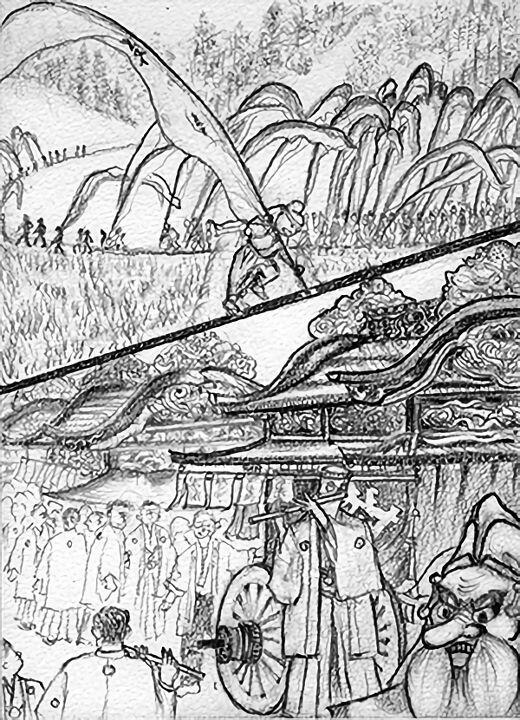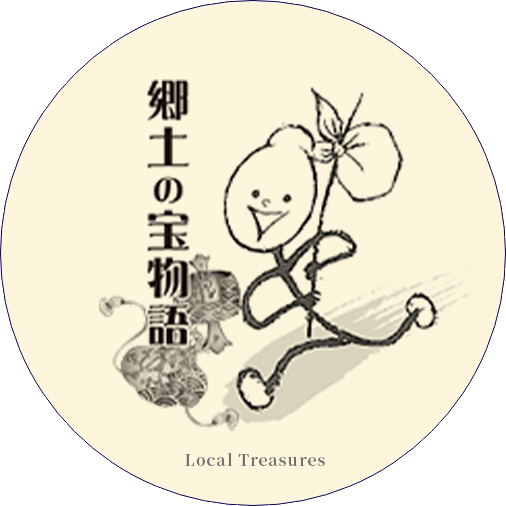| Yeast |
“Besides the Lantern Festival of central Nihonmatsu, we also have more festivals in the other districts of our municipality.” |
| Kimoto |
“Let’s introduce three of them. The first one is the ‘Flag Festival of Kohata’ (‘Kohata no Hata Matsuri’). This festival goes back to Former Nine Years War in the 11th century, between the Abe family, the leaders of old Mutsu province, and generalissimo Yoriyoshi Minamoto. The Minamoto army had lost the battle and had retreated to Mt Kohata with only a few horsemen left. That night snow fell, blanketing the whole mountain in white. The Abe army that was pursuing the Minamoto troops, mistook the white snow for the well-known white flags of the Minamoto army, and thinking there must be a huge army lying in wait, they fled head over heels without putting up a fight. That story is the origin of the Flag Festival. Nowadays, the white flag in front of the procession is followed by flags in many bright colors. This is one of the Three Flag Festivals of Japan.” |
| Yeast |
“What started as a story about white flags, today is a very colorful festival. Besides the parade, there are also ceremonies called Hayama-gomori (a retreat where the participants only eat vegetarian food) and Tainai-kuguri (passing through a cave as a symbol of rebirth).” |
|
 |
| Kimoto |
“That points at coming of age ceremonies for boys of 15 and older. As the traditional ceremonies have been preserved, the festival has been designated an ‘Important Intangible Folk Cultural Property of Japan.’ It is a festival that belongs to winter.” |
| Yeast |
“It is the festival of the Okitsushima Shrine on Mt Kohata. In the shrine grounds you can admire a three-storied pagoda and also the ‘Large Kohata Pine Tree,’ which has been designated a natural monument.” |
| Kimoto |
“The second festival is 400 years old and called the ‘The Harimichi Clash of Festival Floats’ (‘Harimichi no Abaredashi’). In the past, when there were crop failures and epidemics in this area, a float with a doll was offered to the shrine with sacred kagura music. The festival is now held every year in October. On the floats stand large dolls made by local youths. While big drums are booming imposingly, seven floats from the various districts bump furiously into each other.” |
| Yeast |
“Seen from nearby, it’s tremendous! The dolls can be valiant samurai but also characters from anime – the style is free. This is a chance for the young people to show off their original ideas.” |
| Kimoto |
“After the clash of the floats, the shintai (object of worship containing the spirit of the deity) is ceremonially returned to the shrine. The atmosphere is very solemn, completely different from the part with the clashing floats. The final festival is the ‘Crested Kimono Festival of Obama’ (‘Obama no Montsuki Matsuri’). This is held for three days after the Lantern Festival of Nihonmatsu. Four gilded floats with drums parade through the town. When Nihonmatsu in the Edo period was ruled by the Niwa family, the country was ravaged by the Great Famine of the Tenmei Era (1781-1789). In order to pray for recovery, the villagers received permission to donate money and organize a mikoshi procession. The portable shrines were followed by floats with drum stands to carry the food offerings. This festival has been celebrated without change for over 200 years.” |
| Yeast |
“The name ‘Crested Kimono Festival’ originated in the circumstance that young men formally dressed in crested haori and hakama walk in front of the drum floats playing hayashi music. In the past this festival never left its neighborhood, something it was famous for.” |
| Kimoto |
“The first time this festival was held outside its own neighborhood was in 2016, when, to celebrate the municipal reorganization of Nihonmatsu, the four great festivals – including the Lantern Festival – were for the first time in history held together in the castle park under the name ‘Nihonmatsu! Full of festivals! Everybody get together!’” |
| Yeast |
“That was an exceptional and thrilling event! I’d like to see it again!” |
| Kimoto |
“I’m sure it will be repeated in the future.” |
| Yeast |
“I’m impressed that the various districts of Nihonmatsu are so serious about preserving their traditional festivals!” |
| Kimoto |
“Indeed, an enormous amount of energy goes into continuing these festivals. It’s the expression of everyone’s love for their hometown.” |





